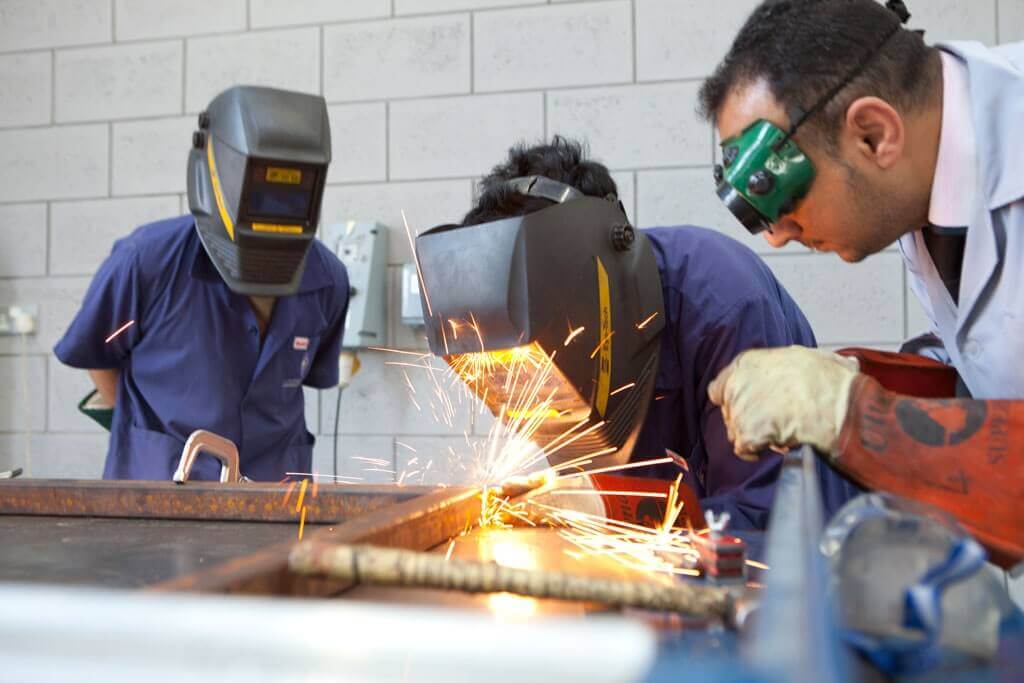
Why a vocational education might be worth it
Perhaps the most depressing thing you’ll learn in microeconomics is the theory that your bachelor’s degree functions as little more than a signal to employers. The diploma matters—but most likely, the four years of all-nighters and 8 A.M. classes and mile-long financial aid forms didn’t fill you with all the knowledge you need for your job. And if you’re the average college student, that four-year bachelor’s degree plunged you $30,000 into debt.
Bachelor’s degrees aren’t meaningless, but they’re not cheap, neither are they the golden keys to money, happiness and fulfilling work. Which is why the integration of vocational and academic education is critical to weeding out the myriad woes of the U.S. education system.
Though widely accepted in Europe, vocational education in the U.S.—including elective classes in high schools, trade school programs and community colleges—has been slower to gain prominence as it shakes off a stigma that dichotomizes technical training from intellectual capabilities. These schools don’t come with Ivy-League bragging rights and have often been viewed as a sub-par alternative for students who don’t like math and books.
But as a complement to traditional education at secondary and postsecondary levels, vocational education offers undeniable benefits that avoid the costliness—and oftentimes, futility—of education at traditional institutions.
For one thing, vocational schools typically cost less than four-year institutions: A bachelor’s degree costs more than $120,000 on average, nearly four times the average $33,000 shelled out for trade school. Meanwhile, the average annual tuition for community college is just $3,440.
More importantly, vocational education can reduce student debt in the long run by helping students land the jobs they need, according to Andrew Hanson, a senior research analyst at Georgetown University. Students who default on their loans aren’t typically the ones with the biggest debts—they’re the ones who don’t complete their programs and don’t get jobs. By preparing students to directly enter the workforce, vocational education programs better ensure employment and thus reduce the likelihood of debt.
A 2016 report by Northeastern University examining secondary vocational education in Massachusetts found that 75 percent of employers across a broad range of industries prefer to hire vocational-school graduates for entry-level positions and 61 percent prefer to hire them for higher-level positions. More than 90 percent of these employers were satisfied with the students they hired from high school vocational programs.
Jobs that require vocational education are in high demand and, depending on the field, can lead to well-paying positions. The top three majors for high-paying jobs are in STEM, business and healthcare—all of which require vocational training. Liberal arts-oriented degrees take mid-paying jobs and other vocational careers, such as social services and education, fall at the bottom of the list.
“Employers are looking for both [academic and vocational skills],” Mr. Hanson said, noting that soft skills such as professionalism and work ethic, developed through vocational education, are particularly valuable.
“If you only have general education, it’s going to be tough to compete with candidates who have field-specific education and work experience.”
So why isn’t everyone on board?
Part of the reason for this hesitance toward vocational education is that people falsely dichotomize vocational education and academic training instead of recognizing that the two can go hand-in-hand. “One reason why more students are not pursuing CTE programs is that critics characterize it as a track for students who are less likely to attend college,” writes Tim Hodges, a director of research at Gallup. “This line of thinking is detrimental to students, employers and the future of our country.”
Until the late 20th century, vocational education in the U.S. was largely focused on technical training, separate from academics. But in 2000, the National Center for Education Statistics reported that the vocational education system was “in transition,” evolving from programs designed merely to schlep kids into entry-level jobs, to programs that incorporated academic training with technical training. A series of versions of the Perkins Act (originally passed in 1984) facilitated this transition by holding schools more accountable for student performance, expanding disadvantaged individuals’ access to vocational education and integrating academic and vocational programs.
Yet, misconceptions are deep-rooted. In 1983, a government report on the education system suggested that mostly low-income and minority students were being “tracked” into vocational programs, sparking widespread aversion and leading many high schools to shut down their vocational education programs. Wealthy people have wrongly viewed vocational education as a route reserved for disadvantaged students, thus perpetuating aversion to vocational education from all sides.
CTE classes were an attempt to bridge the divide and have had some success. Even so, public high schools still focus too heavily on academics and college preparatory classes. Students only have room for a few CTE courses while being pressured to take higher-level academic courses.
What can be done?
More could be done to expand and improve vocational schools in the U.S., allowing students to pursue both vocational and academic education. At the high school level, public schools could offer more and better vocational classes and separate vocational schools could receive more promotion and funding. The Massachusetts study found that a majority of employers thought there weren’t enough career and technical education graduates and 81 percent thought the system needed improvement. At the college level, reforming the accreditation system could help create a level playing field for vocational schools.
Currently, the accreditation system favors four-year institutions by evaluating inputs, not outcomes, Mr. Hanson said. Shifting the focus to outcomes such as student employment—which the Obama administration worked toward with the Gainful Employment Rule—would be “a way to make the whole system more vocationally oriented.”
Expanding access to community colleges is another key element to integrating academics and vocational education, since these institutions tend to offer degrees as well as technical training. Data on the outcomes of vocational programs should also be published to raise awareness.
And finally, misconceptions of vocational education as totally separate from academics, or as a track reserved for lower-income students, should be blown away. Vocational education can be a good option for anyone, regardless of social status. Expanding and encouraging access to vocational education at the secondary and postsecondary levels is also essential. If students have the freedom to pursue what they’re good at—and what the market needs—then money currently spent by students on excess credits and by schools on unhappy students will be channeled to more meaningful ends.
Additionally, students who take on vocational education along with a four-year college track—as many want to—will, in the long run, be more adaptable to the changing labor market. Ultimately, a vocational education is more in line with the American ideals of diversity and individual achievement through hard work. If you’re a good welder, you don’t have to follow the crowd of business majors. If you’re a computer wizard, don’t spend money on history credits so you can shoot for law school. Happiness isn’t landing the highest-paying job—it’s doing what you’re good at, and what helps other people. As usual, choice, diversity and integration, not false dichotomies and conformism, create a win-win situation.
Nicole Ault is studying economics and journalism at Hillsdale College.










